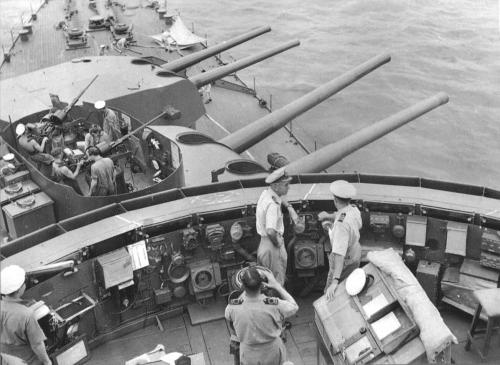- Author
- Wrigley, Ian (Peter)
- Subjects
- Battles and operations, Ship histories and stories, WWII operations
- Tags
-
- RAN Ships
- HMAS Australia II
- Publication
- September 2012 edition of the Naval Historical Review (all rights reserved)
The 1944 Captain’s Night Order Book from HMAS Australia was recently received by our Society from an anonymous donor. The last entry in this book is 20 October 1944, the night before the ship was struck by a Japanese aircraft and badly damaged. How this book survived remains a mystery.
The Night Order Book
Most of our readers will be familiar with a Captain’s Night Order Book which the Navigator arduously prepares each evening regarding courses and speed and special precautions concerning navigation for the Captain’s final comments and signature. This book is then taken to the Bridge where it is initialled by the officers in charge of the First, Middle and Morning watches. Their initials signify the orders have been read and understood.
One of our members, then a young Sub Lieutenant RANR in HMAS Australia, was Ian Wrigley, whose initials are contained in this historic book. Ian was a watch keeping officer whose action station was in the Aircraft Direction Room (ADR) immediately abaft the Bridge compass platform. Ian was at this action station when the ship was hit. On 20 October 1944 the Night Order Book was prepared by the Navigator (and Squadron Navigating Officer), Acting Commander John Rayment, DSC, RAN and countersigned by Captain Emile Dechineaux, DSC, RAN. In tragic circumstances a few hours later these officers were to lie mortally wounded.

(Image:RAN)
Battle of Leyte Gulf
In October 1944 a massive invasion force had been assembled with the aim of retaking the Philippines from the Japanese. The Allied fleet assembled off Leyte Gulf comprised a minesweeping and hydrographic survey group including HMAS Gascoyne and HDML 1074. Troops and equipment were carried in the landing force which included HMA Ships Kanimbla, Manoora and Westralia. A covering force providing shore bombardment comprised battleships, cruisers and destroyers with the RAN supplying the cruisers HMA Ships Australia and Shropshire in company with the destroyers Arunta and Warramunga. After the big guns had done their damage and lay silent the USN brought modified landing craft closer inshore and these launched massive rocket attacks over the landing areas. USN escort carriers provided air cover and were used in neutralising Japanese airfields.
The minesweeping and survey operations started on 17 October and on 19 October the shore bombardment commenced and continued for two days with Australia and Shropshire taking their place in the line firing upon assigned targets. Later on 20 October General Douglas MacArthur was to wade ashore from USS Nashville declaring ‘he had returned’.
With overwhelming Allied air superiority there had been no air attacks on any of the hundreds of assembled ships. Following the successful landing by US troops the major ships anchored. During this evolution at about 16:00 a lone Japanese aircraft appeared and with great audacity flew down the line of ships unscathed and dropped a single torpedo which hit the USN cruiser Honolulu. A huge hole was rent in ship’s side with considerable damage and the loss of 60 lives and many casualties.
The next day ‘Trafalgar Day’ did not auger well for the RAN. In the half-light of dawn the fleet was weighing anchor in preparation to providing fire support as needed by the forces ashore. At about 06:00 radar in Australia’s ADR picked up approaching aircraft and shortly afterwards three planes were held visually and met by a barrage of anti-aircraft (AA) fire from the fleet. While reports of the action are confused two aircraft appear to have been shot down and a third was hit by AA fire from Shropshire but this plane regained control and returned to approach Australia from astern diving at an angle of 10 to 15 degrees. She was engaged by those of Australia’s close range anti-aircraft guns which could be brought to bear including one eight-barrelled pom-pom, a single 40mm Bofor and a pair of 20mm Oerlikons. The aircraft was hit but continued on its attack path with its wing striking the ship’s tripod foremast. Most of the plane’s fuselage fell into the sea but burning debris and aviation fuel rained down upon the open Bridge and the open AA gun mounting above B turret. With secondary explosions the Bridge, B turret and superstructure were soon engulfed in flames. Luckily for Ian Wrigley the adjacent ADR remained intact and the occupants were uninjured. This attack resulted in extensive damage and loss of life with 30 of the crew killed or dying of wounds and a further 64 wounded.




